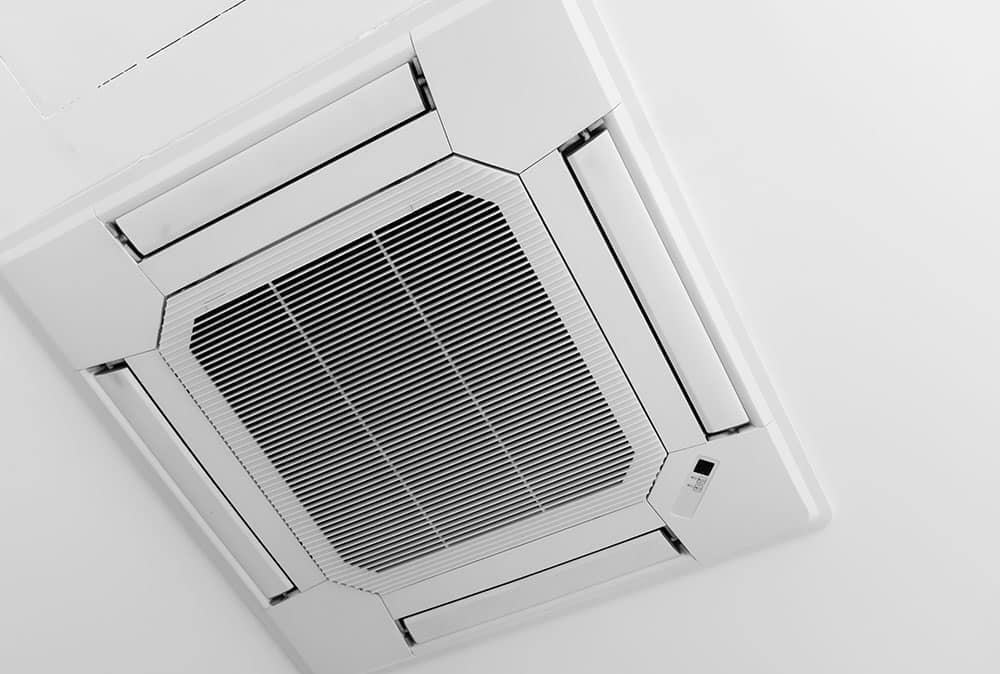Ductless heating and cooling systems consist of an outdoor condenser paired with one or more indoor air handling units. The indoor units can be mounted to your wall, ceiling, or floor. However, floor-mounted units don’t go into the floor. They’re actually wall-mounted units designed to sit low on the wall.
When you select your ductless system, you will need to choose the type of indoor units you want in your home. Here are 9 signs that a ceiling-mounted ductless AC and heater is the right option for your home.

1. Floor-to-Ceiling Windows
Floor-to-ceiling windows can enhance the look of a home, but they make it challenging to install a wall-mounted unit. Ceiling-mounted ductless units can work perfectly in these situations.
For example, many people use ductless units to turn sunrooms with large windows from two-season rooms into comfortable year-round spaces. The windows in these rooms tend to make them too cold in the winter and too hot in the summer, but a ceiling-mounted unit can make these rooms very comfortable and inviting all year long.
2. Short Walls, Sloped Ceilings
In some cases, the walls in your home may simply be too short to comfortably accommodate a wall-mounted ductless unit. In particular, this happens in attics or upper floors with sloped ceilings and low walls. Both floor-mounted and ceiling-mounted units can help you get around this challenge.
3. Walls Covered With Art or Built-in Carpentry
Perhaps, your walls are already covered, and you don’t have the space for a wall-mounted unit. This comes into play if you have fireplaces, built-in shelves, or even walls full of art. A ceiling-mounted ductless unit means that you can keep your walls as they are.
Often, the decision to get a ceiling-mounted ductless unit is personal. Some people don’t want a unit on their walls, or they don’t want anything at all on their walls. In both cases, a ceiling-mounted unit can be the ideal solution.
4. The Desire for a Clean Aesthetic
Ceiling-mounted ductless units are generally much more discrete than wall- or floor-mounted units. They can be suspended from the ceiling, but in most cases, they’re actually recessed into the ceiling. This means that all you see is a grille — many homeowners prefer this clean aesthetic.
5. Strong Preference About Line Hide Placement
Ductless heating and cooling systems have refrigerant, drainage, and electrical lines that run from the indoor units to the outdoor condenser. Generally, these lines go out a very small hole in your wall, and then, they run through a line hide down the outside of your home to the condenser.
Generally, the line runs from the exterior wall where you place your wall-mounted unit. However, if you don’t want the line hide on this side of the home, you may want to consider a ceiling mount. Then, you can run the line through the ceiling and down the back of the house.
Note that line hides are very discreet. Most people don’t really notice them at all. However, if you have a strong preference, this may be something that you want to consider.
6. Large Room That Needs Multi-Direction Airflow
Most ceiling-mounted ductless cassettes come with multi-direction airflow. In contrast, the air from a wall-mounted unit tends to move in a single direction. Multi-directional airflow can be helpful in any space, but it’s particularly useful in large common areas such as an open-plan kitchen, living, and dining room.
If you want bi-directional airflow, consider a rectangular ceiling-mounted unit that has dual-vane technology. If you want air to flow in four directions, you may want to look at a square-shaped ceiling-mounted unit.
7. Ample Ceiling Cavity Space
In addition to thinking about your personal preferences, you also need to make sure that your home can accommodate a ceiling cassette. In almost all cases, it’s easy to install recessed ceiling units on the upper floor of your home. However, if you want to install them on your first floor, you need to ensure that you have at least 10 inches of space between the ceiling and the floor above it. You also need to ensure that recessed lighting, vents, or other obstructions aren’t in the way.
8. Cost of Ceiling-Mounted Ductless
Typically, ceiling-mounted units cost more than wall-mounted units. Some of the extra cost comes from the additional technology in these systems, such as multi-vane airflow. The other increase in cost is due to the extra labor required to install ceiling-mounted ductless systems.
However, the cost is not significantly more. Homeowners who prefer the convenience and the aesthetic of ceiling-mounted ductless units are generally happy to pay the slightly higher cost for these units.
9. Installation Considerations for Ceiling-Mounted Units
Before selecting a ceiling-mounted unit, make sure that you’re ready for the installation process. Installing a ceiling mount takes more labor than installing a wall-mounted unit. When a consultant comes to your home, they can give you an idea of the labor involved in your situation.
For instance, if you have recessed lights, they can often just remove a light to peak at the area above your ceiling to see if it can accommodate a ceiling-mounted unit. Otherwise, they may be able to find out this information by making a very small hole in a discreet part of your ceiling.
When they install the system, they will have to make a hole in the sheetrock. This allows them to push the unit into the ceiling so that only the outer grille is visible. This isn’t necessary with a wall-mounted unit. Additionally, if you opt for a square-shaped ceiling-mounted unit, a carpenter will need to cut through the joists or rafters and then create a box to hold the unit.
Should You Get a Ceiling-Mounted Ductless System?
You should consider a ceiling-mounted ductless system if your walls don’t have room for a wall-mounted unit or if you prefer to have your ductless system discreetly hidden in your ceiling. Ceiling mounts cost a little more and take a bit more time to install, but they’re worth the time and money.
If any of these elements apply to your situation, you should consider a ceiling-mounted ductless unit. Keep in mind, however, that you don’t need the same unit for every room in your home. In a lot of cases, you will end up choosing different styles of units for different rooms in your home.
Want help selecting the best ductless unit for your home? Want to know if a ceiling-mounted unit can work in your home? Then, contact us today. At NETR, Inc, we have over 30 years of experience in the HVAC industry, and we’re excited about sharing our knowledge and experience with our clients.
Our focus is on your comfort, and when you contact us, we’ll work closely with you to customize a heating and cooling solution that meets your unique needs. There’s no one size fits all solution to heating and cooling — to see how we’ve helped other homeowners, check out our case studies.
